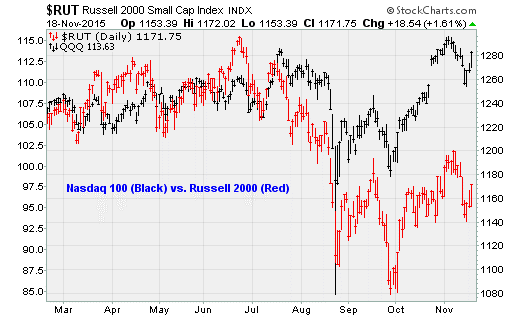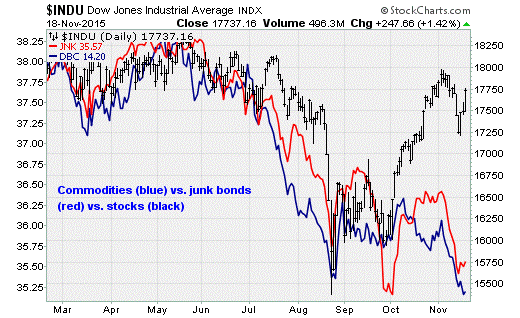Below the surface, Wall Street is still nervous
U.S. equities rose again on Wednesday, pushing large-cap stocks up an impressive 4 percent from the futures market low recorded just after the Paris terror attacks. However, those large-caps stand alone, with most other areas of the market decidedly less ebullient.
And that suggests concerns seen earlier this month about the fallout from a likely Federal Reserve interest rate hike in December are set to return.
The chart below shows how the big-tech stocks in the Nasdaq 100 index have separated from all the small-cap stocks in the Russell 2000 index. That's a symptom of narrow "breadth," or buying interest, as investors focus on fewer and fewer stocks. While the Nasdaq 100 flirts with record highs, the Russell 2000 remains mired in a four-month trading range.
The next chart compares the Dow Jones industrials to the action in high-yield corporate bonds and commodity prices. Large-cap stocks separated from these other markets in October and have yet to realign.
Other indicators, from the relative demand of equity put options (betting on a price decline) to call options (betting on a price rise) as well as the multiweek rise in the CBOE Volatility Index (VIX) -- also known as Wall Street's "fear gauge" -- all suggest a sense of apprehension just under the surface.
Turning back to the Fed minutes, Michael Hanson at Bank of America Merrill Lynch noted that policymakers generally saw an improved global outlook in October. Labor market concerns grew stale in the wake of the blowout jobs report seen earlier this month.
A lack of conviction in the inflation outlook -- with the Fed desiring a return to its 2 percent target over the medium term -- remains the last major hangup for rate liftoff. Hanson believes ongoing strong job gains and a waning inflation drag from low commodity prices should alleviate these Fed concerns.
One possible hurdle is the way long-run inflation expectations have weakened slightly. Still, the futures market continues to put the odds of a rate hike next month -- something that hasn't happened since 2006 -- at around 80 percent.
Through the end of last week, investors were growing increasingly nervous about the consequences of the first increase in the cost of credit in nearly a decade. As recent bullishness related to the aggressive response from France, the U.S. and Russia to the latest terror attacks fades, investors could refocus on this issue. And that could result in renewed selling pressure heading into the Thanksgiving holiday break with markets closed next Thursday.


